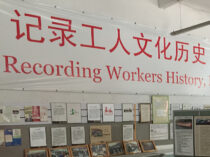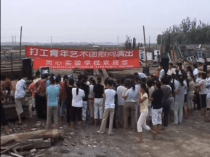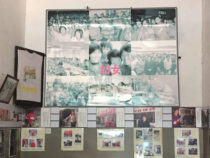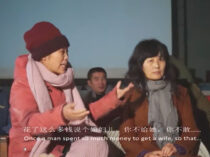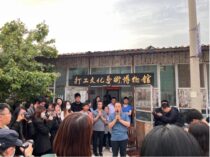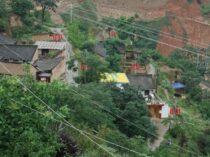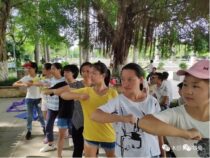On the Adventures of Site-Specificity: documenta 14 in Athens and Maria Eichhorn’s Art Project Building as Unowned Property
On the Adventures of Site-Specificity: documenta 14 in Athens and Maria Eichhorn’s Art Project Building as Unowned PropertyEva Fotiadi Documenta 14 is likely to remain in history as the documenta edition that was received with skepticism and critique not so much for the art it presented or for how it presented it, but for the legitimacy of the curatorial gesture that it set out to perform: to learn from Athens. At the time when documenta 14’s title, Learning from Athens, was made public in 2014, following the regular procedure of appointing an international committee to select among the curatorial proposals of invited candidates, Greece had already been five years into a debt crisis. Compared to other Western states hit by the 2008 global financial crisis, Greece experienced a recession that was more profound and lasted longer. Commentators usually refer to the impact of the recession in Greece as the “Greek Crisis,” which involved the Greek state’s financial collapse, three successive bailout loans given by the European Union and the International Monetary Fund between 2011 and 2015, the tough reforms and austerity measures imposed on Greek economy by its lenders, the resulting impoverishment of a significant part of the country’s population, and the political and social unrest that went on for years especially in Athens. Moreover, animosity developed between the people of Greece and Germany as the latter’s government had taken the lead in the EU’s hardline stance toward the Greek state. In the midst of the above situation, it was announced internationally that the upcoming documenta—the German-based quinquennial contemporary art event that has an enormous cultural prestige and budget, —would take place in both Kassel and Athens. Various voices posed questions: what did Athens stand for that made it so interesting for documenta to move to and learn from? What kind of agency did documenta’s leadership (whether embodied in the 14th edition’s artistic director Adam Szymczyk or in the German limited liability company Documenta gGmbH that runs the institution from Kassel) expect the art event to present itself as in Athens? What was Athens itself seen as, and what did the self-invited, long-term, and well-off guest expect to learn from it? As if Athenians were not already busy enough addressing not only the Greek, but also the so-called “refugee crisis,” caused by the Syrian war. Would the arrival of documenta 14’s team, artists, and visitors to Athens be substantially different to crisis tourism? How was the curatorial gesture different from the tradition of the colonialist taking an anthropological interest in the “Other”―usually Southern and objectified? Or how was it different from the ethnographic turn in art described by Hal Foster two decades before [1], in which the artist―and here the curator―went searching for an oppressed “Other” located in a social, ethnic, racial, or geographic “elsewhere.” In this article, I will engage mainly with the questions of what Athens stood for, as a site, in the much-discussed title Learning from Athens. The first part of this article is a reflection on two ways in which Athens was approached curatorially in documenta 14 and their critical reception. In the second part of the article, I will focus on one work in particular, Maria Eichhorn’s Building as Unowned Property, which was the artist’s site-specific project for the Athenian leg of documenta 14. Compared to the same artist’s much praised project for Kassel, Rose Valland Institute, which investigated the expropriation of Jewish properties by the Nazis, Building as Unowned Property received much less attention. Nonetheless, as I will maintain in this article, it was a very timely and subtle project of conceptual public art. Eichhorn’s work responded to different interpretations of documenta’s specificity to Athens. Accordingly, its own local reception reflects fundamental criticisms addressed towards documenta’s approach to Athens, as well as weakness in the argumentation of these criticisms. “ATHENS” Probably the most discussed aspect of documenta 14 was its title, Learning from Athens.[2] The title placed the focus on the city of Athens. In early interviews and discussions with Adam Szymczyk, the event’s artistic director who invented the title, the approach to “Athens” or to the phrase “from Athens” was twofold. On the one hand, Athens was seen in its specificity, as this particular city, with the particular financial, political, geopolitical, social, cultural, historical conditions that it had been experiencing over the years of the so-called Greek crisis, and to which citizens had reacted in various ways.[3] Accordingly, in a 2014 interview Szymczyk mentioned that, as an optimist, he predicted Athens would be a place where one would want to be and live within three years. He considered Athens worthwhile not merely as an image of the crisis, but also as a center of cultural production.[4] This approach to the city was also the interpretation of “Athens” that dominated in Athenians’ initial understandings of documenta 14’s title.[5] For some of them, this was the only way to understand the curatorial approach of documenta 14, and they remained sceptical or acrimonious towards it. In an infamous Athenian graffiti—“Documenta, I refuse to exoticize myself to increase your cultural capital. Sincerely, the Indigenous”—documenta’s team was clearly compared to the European colonialists who headed South to study the Other, with an instrumentalizing and at times voyeuristic approach to learning from a place and its population.[6] Yet, on the other hand, Szymczyk and his team clearly considered Athens an example of global neoliberal politics and its effects in the early 21st century. This approach is not about observing Athens as a specific place but as “exemplary of the fast-changing global situation” and of “current issues that extend beyond the proverbial notion of the Greek crisis.”[7] From this curatorial perspective, the organization of the exhibition in Kassel and Athens was “meant as a kind of generator,” as “it establishes a certain grammar and opens a field for transformation and generates new meanings that can be discussed and located in places that are outside of this dichotomy between the two cities.”[8] Accordingly, the term “South” was meant to function “as a kind of shifter that can be deployed in different locations politically.”[9] In this spirit, the first issue of South as a State of Mind [10] featured theoretical and artistic contributions derived from post- or neocolonial experiences in Réunion Island, Morocco, Nigeria, and Algeria[11] This second approach to Athens is close to how scholars in urban studies use terms related to the concept of “the urban.”[12] Since the title Learning from Athens places the accent on knowledge gained from a city, it seems appropriate to consider how urban space scholars unpack their object of study. In Global Urban Politics. The Informalization of the State (2016), Julie-Anne Boudreau describes the urban as a “specific mode of relation to space, time and affect, marked by mobility, intense interdependence, discontinuous spaces that carry emotional significance and multiple temporalities” (p.10). Boudreau defines urbanity as a geographically uneven set of historical conditions, conditions which affect ways of life, modes of interaction, economic transactions, political relations, and worldviews. She compares “urbanity” to modernity, and how modernity was or still is unevenly distributed around the globe (p.12). Very important for Boudreau’s concept of urbanity is its relation to a specific logic of action, the beginnings of which could be placed in the late 1960s, when novel forms of political mobilization specific to urban centers flourished. By now, after decades of neoliberalization and challenges to the nation-state, urbanity’s logic of political action is becoming more visible (p.13). Hence, through the urban scholar’s lens, it seems meaningful to focus on the level of cities, of the urban, in order to analyse aspects of contemporary neoliberalism. In the above I have quoted at some length Boudreau’s theory of urbanity as a set of historical conditions, as well as the significance that she attributes to the late sixties in the rise of certain forms of political action characteristic to urban centers. The reason is that her perspective shows close similarities with documenta 14’s interest in specific histories of political repression and protest, from Greece and elsewhere. For instance, during the first ten days of “The Parliament of Bodies” in Athens significant attention was given to the military junta in Greece between 1967-1974.[13] Guests included, political activists, artists and scholars of various disciplines including several historians. Later events of “The Parliament of Bodies” in Athens and in Kassel engaged with memories from around the globe of anti-colonial struggles, the NonAlignment Movement, LGBT+ struggles, and so on. From such a perspective, and in the context of global politics, one can also comprehend the logic behind Adam Szymsyk’s statements in the controversial interview he gave right after documenta 14’s opening in Athens in April 2017. There, he stated that documenta 14 approached Athens as an example in global politics, and as such Athens could be considered interchangeable with, for example, Lagos in Nigeria or Guatemala City.[14] This second approach to Athens in the context of global urban politics in the early 21st century is not unreasonable. It is also very much in tune with how globalization and socio-political engagement are understood and performed in the world of contemporary art and of art and theory, where people, products, and concepts are in constant movement between exhibitions and other events around the globe. One is reminded, here, of Miwon Kwon’s genealogy of site specificity in contemporary art.[15] According to Kwon, the concept of the “site” has gradually been deterritorialized: initially referring to a physical or architectural environment, the “site” has moved on to referring to the social context of a place, to specific communities, and to social or political discourses with which artists engage. Eventually, as artists who gained professional visibility were increasingly invited to one place after another to work site-specifically on issues identified with their oeuvre, artists started functioning themselves as a kind of deterritorialized, mobile site. This trend has been gradually entrenched by previous editions of documenta, starting with Catherine David’s documenta 10 in 1997. Theoretically speaking, the two interpretations of the approach to Athens that are discussed here—Athens as a particular city and Athens as an example of global developments—do not need to be mutually exclusive in a curatorial project. In the world of art, it is often valued that concepts and terms are kept open to multiple readings. Nonetheless, in the case of curating documenta 14, interpretational narrowness and openness were not without critical implications for critics and participants alike. For example, if one were to claim that the second approach to Athens constitutes the most “contemporary” or “urgent” reading of the title Learning from Athens, then one could also claim that critics who ignored this reading before, during, and after the exhibition remained stubbornly stuck on the first approach of site-specificity to the city. Probably because this interpretation spoke to them personally the most, as Despoina Zefkili has shown for members of the local art scene, who were disappointed in the documenta curators or artists’ interaction with them.[16] Nonetheless, in the actual practice of staging documenta 14 as a cultural event operating from within the city of Athens, the curatorial openness to both approaches as well as the preference for the second one, created a paradox for invited artists: if Athens becomes a kind of synecdoche, a stand-in for broader, global politics that can be better observed as they play out at the level of the urban (rather than the national etc.), then this can lead to a paradoxical situation for artists who were commissioned to create new works.[17] Some responded to the invitation by coming to Athens to live and experience the city; others did in situ field research. The aim was to develop projects in response to the city of Athens and its people in particular. Yet they did so while functioning under a curatorial concept that envisioned Athens not as a particular city, but as a synecdoche for something larger, as interchangeable, for example, with Lagos or Guatemala City. The implications of this paradoxical position reflected negatively on some site-specific art commissions, as Bram Ieven has shown in a couple of examples of public art, including Roger Bernat’s performative piece The Place of the Thing. In Ieven’s view, commissioned projects like Bernat’s that attempted to engage with broader political issues barely escaped what the curatorial project tried to denounce: that it was instrumentalizing the local as a stand-in for the global. Bernat’s project was a participatory performance with dramaturgy by Roberto Fratini. The artist had invited local groups and collectives to tour a replica of a large ancient Greek stone in whichever way they wanted. The stone was supposedly a replica of the Oath “lithos” from the ancient Athenian Agora which would eventually travel from Athens to Kassel. Summing up the aims of his project, Bernat explained that it was “about seeing which kind of cultural meaning, political value or even religious charisma can acquire for different collectives and individuals an archeological piece. And to see how individuals and collectives can negotiate the absolute pretext the object represents.” [18] The ancient stone replica obviously relied on a romanticized perception of Athens as the cradle of Western culture and democracy constructed by West Europeans since the 18th century and seen as represented in ancient Greek ruins. Nonetheless, what turned out to be the most disturbing aspect of using Athens as a mere stand-in was the blunt indifference that the artist expressed towards the participating groups’ opinion about his project. This indifference was expressed when one of these groups, the so-called LGBTQI+ Refugees in Greece, “kidnapped” the stone in protest against what they saw as the fetishization and exploitation of the refugee crisis by the artist. In a press release that Bernat and Fratini published after the kidnapping, they described the group’s protest as merely an implementation of the project’s aims. Moreover, the two made clear that from the perspective of the artwork’s concept, both the stone and the group were interchangeable with any other stone and group. In conclusion, one could argue that the function laid by the curatorial framework of documenta 14 on the city of Athens as a site to learn from, or from within, as well as the ambiguity of what Athens as a functional site was interpreted as, created a field of tensions between parties who understood themselves as stakeholders of the documenta 14 project.[19] Tensions that are revealed when art intervenes in discourses of the social or the political sphere are often seen as a potentially productive force. However, such a positive potential was only marginally realized in the unfolding of documenta 14 and in its reception.[20] Site-specific public art in urban spaces often functions as a useful barometer of tensions. That is because this art takes place in or creates mental and aesthetic spaces in between “art” and “reality,” between the private and the public. While “urban” and “public space” might be productively open concepts in art and in theory, in the daily life of a city they are experienced as concrete realities. The gravity of the daily tensions and inequalities that permanent and temporary residents of Athens had been experiencing since the beginning of the so-called Greek crisis and refugee crisis is something that curators and artists might sometimes have taken too lightly. When this recklessness backfired in documenta14’s reception, especially its curators took on a defensive stance. Yet big art events as well as commissioned art in public space are directly or indirectly almost always complicit with the (art) market, as well as socio-economic and political interests. Art is labor and produces value, it doesn’t exist besides economy. That said, art, and while acknowledging its relations of production, can at times produce mental and aesthetic spaces that enable one to imagine and claim economy and society otherwise. As already mentioned above, some of documenta’s critics remained adamant in not accepting that the exhibition event in general, or individual artistic and discursive projects in particular, could potentially open up for them spaces for thinking, sensing and claiming the site of Athens otherwise. Building as Unowned Property in Athens Another public art piece commissioned by documenta in Athens was Maria Eichhorn’s site-specific project, Building as Unowned Property. It too was received with suspicion. Eichhorn attempted to buy a vacant, two-story neoclassical building in the area of Ameriki’s Square in order to have it turned into a property without owner. Ameriki’s Square (Plateia Amerikis) is located in a residential district in central Athens. Early in the 20th century the area was largely upper-middle class. The district’s neoclassical architecture attests to that history. However, since several decades, the most affluent residents moved out and were replaced by lower-income Greeks and immigrants, who could buy or rent properties at low prices.[21] Eichhorn’s project is comprised of the act of converting the building’s legal status into ownerless property, of legal studies that the artist commissioned to lawyers to that end, of the documentation of the whole acquisition and conversion process, and of the building and the plot at 15 Stavropoulou Street. The project was presented in documenta’s exhibition at the National Museum of Contemporary Art in the form of two display cases containing a selection of documents from the process. The exhibition text read: Maria Eichhorn’s artwork consists of converting the status of a neoclassical building in the area of Plateia Amerikis into that of unowned property. Acting within the existing Greek legal framework the property is designated for public use, to be legally converted into a property that de facto does not belong to anyone. Once its status has been changed the building will exist in the city much in the same way that a sculpture does in public space, disputing fixed notions of public and private property vis-à-vis the impact of economic crisis in urban space. The Migros Museum for contemporary art in Zurich, Switzerland, raised 140,000 Euros for the property’s purchase. It also acquired the documentation pertaining to Eichhorn’s artwork, since the artwork itself cannot be owned and thus sold or purchased by a third party. There was no planned use for the building after its purchase. In practice, this meant that the building would be maintained but remain vacant, out of market circulation and out of commercial or private use, except for uses declarable as lectures, workshops, research meetings, etc. The challenge was that no legal or economic framework existed for ownerless property. Only by declaring the building a sculpture in public space could this extraordinary transaction occur.[22] One may easily see a reference here to Eichhorn’s Maria Eichhorn Aktiengesellschaft (Maria Eichhorn Public Limited Company), commissioned by documenta 11 in 2002. The artist used part of the project’s budget to form a public limited company. Upon its establishment, all the shares were transferred to the company itself. By not belonging to shareholders, the company essentially belongs to itself, making it forever impossible to sell or buy. As such, the assets assigned to the company remain unchanged, and unlike the usual aim of such companies to create surplus value, this is impossible here. In 2007, the exhibition and presentation rights of Eichhorn’s project were purchased by the Van Abbe Museum in Eindhoven, the Netherlands. At the time of documenta 14’s presence in Athens, the district around Ameriki’s Square was in the early stages of gentrification. International real estate investment companies and individuals including art world professionals had started buying properties in areas such as Ameriki’s Square for a fraction of equivalent properties’ market prices in other West European capitals. Some people argued that documenta 14’s indirect promotion of Athens as an exciting and affordable capital was contributing to this kind of gentrification. In the context of Athens as a specific city, with its residents’ tangible daily experience of their livelihoods shrinking, their properties losing value, and foreigners speculating on locals’ resulting needs, Eichhorn’s Building as Unowned Property raised anger. It was seen as an act “in the context of hyper-conceptual-art-discourse,” detached from and ignorant of the realities of actual citizens living in the area, and in this sense exclusive and belittling towards them.[23] An interesting aspect in the arguments of some critics was that they explicitly expressed their acceptance for the reality of gentrification in Athens—even though they condemned it—as well as their persuasion that this reality could not change: “there is and never will be a thing as an ‘unowned property’ since even the air that we breath everyday is ‘drenched’ in ideology and subject to power structures.” (Studio 14, 2017) For other critics, whose perspective resonated with the view on Athens as an example of global neoliberal politics, the possibility of an artist bringing Swiss money to Greece to buy real estate at fire-sale prices, intervening in the local law, and so on was judged as reinscribing Eichhorn’s gesture in the very ideological framework of (disaster) capitalism and neocolonial exploitation that the artist had set out to oppose.[25] Interestingly, Eichhorn was not the first one to consider the idea of using or bending the law in order to investigate and pursue possibilities in the Athenian real estate landscape during the financial crisis. There existed in Athens both single artists’ projects and bottom-up collective and multidisciplinary social initiatives, which had been trying to rethink, exploit, or shift the legal frameworks of ownership in order to address the double problem of homelessness and the excess of vacant residential and commercial space after 2009. For instance, the Greek artist Sophia Dona developed for the Athens Biennial the project AKINITO/IMMOBILE (2016-2017). The title used the Greek legal term for real estate or landed property.[26] Dona’s project started as an investigation in how to block the commodification of specific immobile properties and to convert them into affordable housing for herself and the people around her. In pursuit of this aim, she considered a combination of existing examples in Germany and Switzerland where groups of people form cooperatives and co-acquire houses they couldn’t afford alone, with a clever appropriation of the existing Greek laws. Housing construction in Greek cities during the 20th century relied on an economic model that allowed property owners to collaborate with constructors in order to build apartment buildings on their property. This economic model was based on two laws: the law of individual horizontal property and the law for undivided shares or else tenancy in common. Based on these two laws, even small-scale owners of single-family houses with no liquid capital could replace their single-family house with an apartment block and become their owners of apartments. Some apartments would be sold for construction costs and some would stay in the family. When such properties were bequeathed to the next generations, the law of undivided shares in combination with family structures resulted in a complex situation where even individual horizontal properties might have multiple owners. Sometimes it is de facto impossible for such properties to return to the real estate market, because that would require common agreement from all owners. Owners do not always agree and sometimes it is impossible to even locate them all. This situation has also led to properties remaining indefinitely vacant. There also exist local multidisciplinary collectives such as KOINO ATHINA and Co-Hab (both include architects and urbanists), which have undertaken initiatives for research and development of conceptual models and practical proposals that intervene in the existing legal frameworks of housing. The research of these two collectives focus on urban commons and the quality of affordable housing.[27] Co-Hab is a practice-based research project that seeks to develop cohousing and collective ownership models. Sophia Dona’s and Co-Hab’s projects share with Eichhorn the vision that it could be possible to set targets that appear utopian and use the law in order to develop legally valid processes that can become reproducible.[28] One could argue that projects like AKINITO/IMMOBILE and Co-Hab are rooted to local life and offer solutions to locals. Meanwhile, Building as Unowned Property is radical conceptually with regard to property law, but as an artwork it is conveniently rooted to an art-world status quo, not least because the Migros Museum in Zurich acquired the documentation of an artwork by a well-established artist. The documentation was also what appeared in documenta 14’s exhibition in Athens. Nonetheless, returning to the two interpretations of “Athens” as in the title Learning from Athens, as well as considering how a site-specific artwork might act as an instrument of criticality by stepping into rather than representing from an assumed distance problematic conditions specific to its site, I would argue that Eichhorn’s project was quite successful. It responded to the specificity of the district’s process of gentrification, to the phenomenon of urban gentrification globally, and to the role that cultural producers often play in such processes. Moreover, the project clearly demonstrates that the cultural capital of Maria Eichhorn as a well-known conceptual artist and documenta as a prestigious art event can afford a property that will remain vacant, out of use (besides the uses to be declared: lectures, workshops, research meetings, etc.) and out of circulation. The monetary exchange was in a certain sense double, since value will continue to exist for the documentation of the artwork and its owners―because even though Eichhorn’s art piece and the building cannot be owned, the documentation can. It also illustrated to anyone familiar with property values elsewhere the extreme decline of a local economy at the time, as in most West European cities this amount would barely come close to the combined value of an inner city listed house and its plot. Part of the criticisms the work received within a local activist discourse was that the area around Ameriki’s Square could use the money to fund social structures that the residents needed. By making also the way of sponsoring public, Eichhorn foregrounded the undeniable imbalance between the self-invited documenta 14 and the local art and activist scene. Eichhorn’s work is a kind of synecdoche: it stands for documenta 14 in Athens, its excessive spending, its performance and reproduction of inequality. Eichhorn performs an institutional critique of the art world’s complicity with capital by placing herself right in the middle of it. All of this may read like a one-way criticism of Eichhorn’s project. Yet the project appears consistent with the most self-conscious practices of institutional critique, however “hyper-conceptual” these might be. Maria Eichhorn didn’t shy away from acknowledging the involvement with socio-economic art world relations of artists like herself. As a site-specific intervention, Building as Unowned Property did not point a finger at neoliberal and neocolonial economic relations as represented in crisis-ridden cities like Athens or at powerful cultural institutions like documenta. Rather, it presented—it adapted and performed—the operation and logic of complicity within its very structure and form of implementation. The gesture brings to mind Andrea Fraser’s argument that institutional critique is first and foremost artists’ critical self-reflective examination of their own roles and acts vis-à-vis dominant power structures and the attempt to shift such structures with small steps from within.[29] Unlike other site-specific public art commissions such as Bernat’s, which either asked for the locals’ participation or relied on Western aesthetic stereotypes of a half-invented Greek antiquity, Eichhorn’s intervention relied on conceptual art’s aesthetics of bureaucracy and administration. It is significant that the core of the project was an attempt to convert the legal status of a building by intervening in the bureaucratic framework of its ownership. Instead of foregrounding gentrification as a question of financial capital (or of financial capital as a question merely of money), Eichhorn shifted our attention to legal frameworks, bureaucratic frameworks, and, eventually, the limited conceptual frameworks of ownership, of the public/private dichotomies that orient our understanding of how we inhabit and use urban space. In doing this, she mobilized legacies of hyper-conceptual art discourse and its analysis of the logic of administration in order to intervene in reality.[30] Eichhorn did not perform social engagement with a return ticket in her back pocket.[31] To conclude, let me go back to Eichhorn’s use of the legal framework around public sculpture (monuments) to break the link between property and ownership. Besides this very pragmatic appropriation of the art monument’s function in public space to perform a legal trick, one could also see the building as a different kind of monument. Physically present and maintained, bereft of any commercial or domestic use, the building could function as a monument to documenta 14 in Athens. It would be a monument to the discourses and controversies that were raised, to the multiple ways in which documenta engaged with debt as an issue and an experience, and to the debt it amassed. Moreover, the vacant Building as Unowned Property could stand there as an empty signifier to remind that the moment of the crisis was one in which all directions could had been, or at least had seemed to be, potentially possible. It would also remind that the ephemeral mega-event of documenta 14 could had been, or at least it seemed like it could had been, a potential catalyst. Eva Fotiadi is a historian of contemporary art. Her expertise lies in collaborative and interdisciplinary artistic practices, site-specific projects and relations between art, design and the public. She is the author of The Game of Participation in Art and the Public Sphere (Maastricht, 2011) and her texts have appeared in English, Dutch, German, Greek, Polish, Russian and Arabic. She has been a research fellow at Princeton University and at Free University Berlin (DRS, Marie Curie). She is a lecturer at St Joost School of Art & Design (The Netherlands). Together with Prof. Maria Boletsi she coordinates the research group Crisis, Critique and Futurity at the University of Amsterdam. Notes [1] Hal Foster, “The Artist as Ethnographer,” in The Traffic in Culture. Refiguring Art and Anthropology, ed. George E. Marcus and Fred R. Myers (Berkeley, L.A. and London: University of California Press, 1997), pp.302–309. [2] Despina Zefkili. “Definition of ‘From’,” All Collected Voices, Goethe Institut Athen, April 22, 2017. http://www.all-collected-voices.org/open-recording-3-despina-zefkili-kostis-stafylakis-makis-malafekas (accessed February 24, 2020); Theophilos Tramboulis and Yorgos Tzirtzilakis, “When Crisis Becomes Form: Athens as a Paradigm,” Stedelijk Studies, no. 6 (2018). https://stedelijkstudies.com/journal/when-crisis-becomes-form-athens-as-a-paradigm/ (accessed February 24, 2020). [3] See, e.g., Despina Zefkili, “Documenta 14, Adam Szymczyk: Γιατί Τα Επόμενα Χρόνια Όλος ο Κόσμος Της Τέχνης Θα Μιλάει Για Την Αθήνα,” Aθηνόραμα, October 16, 2014; Iliana Fokianaki, “Documenting Documenta 14 Athens.” Metropolis M, 5 May 2017 https://www.metropolism.com/en/opinion/31387_documenting_documenta_14_athens (accessed February 24, 2020). [4] Despina Zefkili, 2014. [5] For a critical response from the perspective of the city’s local cultures of solidarity, see, e.g., Stavros Stavrides, “What is to be learned? On Athens and Documenta 14 so far,” Afterall, spring/summer 2017, pp.65-69. [6] Interesting here is also the brief analysis of Tramboulis and Tzirtzilakis, who argued that part of the local critics of Documenta 14’s approach to Athens showed no interest whatsoever in the artistic or discursive content presented by the exhibition and accompanying events. See, Theophilos Tramboulis and Yorgos Tzirtzilakis, “When crisis becomes form: Athens as a paradigm,” Stedelijk Studies 6 (spring 2018), https://stedelijkstudies.com/journal/when-crisis-becomes-form-athens-as-a-paradigm/ (accessed April 30, 2020). [7] “Documenta 14 intends to learn from the city of Athens and its citizens, instead of parachuting a prepackaged event from Kassel into one or several picturesque venues,” Biennial Foundation Magazine https://www.biennialfoundation.org/2014/10/documenta-14-kassel-learning-from-athens/ October 7, 2014 (accessed February 24, 2020). [8] Simen Joachim Helsvig, “The View from Karasjok,” Nordic Art Review, September 14, 2016. https://kunstkritikk.com/the-view-from-karasjok/ (accessed February 24, 2020). [9] Simen Joachim Helsvig, 2016. [10] South as a State of Mind was the preexisting magazine of Kunsthalle Athena, a local institution founded and ran by Greek curator Marina Fokidis. Kunsthalle Athena became the host institution of Documenta 14th in Athens and Fokidis joined its team as a curatorial advisor. Between 2015 and 2017 the magazine was adopted and edited by Documenta 14’s team as their official periodical. [11] See also, Eva Fotiadi, “Art, Crisis and Their Multiple Audiences,” in Being Public. When Art Creates Its Public, ed. Jeroen Bomgaard and Rogier Brom (Amsterdam: Valiz, 2017). [12] Ash Amin and Nigel Thrift, Cities: Reimagining the Urban (Cambridge: Polity, 2002); John A. Hannigan and Greg Richards, The Sage Handbook of New Urban Studies (Los Angeles: SAGE, 2017). [13] https://www.documenta14.de/en/public-programs/927/the-parliament-of-bodies The Parliament of Bodies. 34 Exercises of Freedom. September 2016 (accessed February 24, 2020). [14] „Reaktion auf Kritik aus Athener Kunstszne. Adam Szymczyk im Gespräch mit Vladimir Balzer,“ Deutschlandfunk Kultur, April 7, 2017. https://www.deutschlandfunkkultur.de/documenta-chef-adam-szymczyk-reaktion-auf-kritik-aus.1895.de.html?dram:article_id=383349 (accessed February 6, 2020). [15] Miwon Kwon, One Place After Another. Notes on Site-Specificity (Cambridge, Mass.: The MIT Press, 2002). [16] e.g., Zefkili, 2017; Zefkili, Despina, “’Exercises of Freedom’: Documenta 14,” Third Text, February 2017, http://thirdtext.org/exercises-freedom-documenta14 (accessed February 27, 2020). [17] For the paradoxical position of artists commissioned by Documenta 14, see also Bram Ieven, “Documenta Athene Een Leerstuk,” RektoVerso, September 14, 2017. https://www.rektoverso.be/artikel/documenta-athene-een-leerstuk- (accessed February 24, 2020). [18] Roberto Fratini, Roger Bernat, “Let’s put things in its place,” press release, May 22, 2017 http://rogerbernat.info/en/general-en/lets-put-things-in-its-place-2/ (accessed April 28, 2020). [19] For the concept of the “functional site” see James Meyer, “The functional site, or: The transformation of site specificity,” in Documents 7, (fall 1996), pp.20-29. [20] Attempts to explore constructive ways to approach the event of Documenta 14 with its prons and cons appeared mainly in (semi)academic platforms, such as events of the research project Learning from Documenta, and articles publications, such as Elpida Rikou and Eleana Yalouri, “Documenta 14 Learning from Athens: The response of the learning from Documenta research project,” in Field. A Journal of Socially Engaged Art Criticism 11 (fall 2018), special issue: The Art of Research Practices between Art and Anthropology, ed. Rikou and Yalouri https://field-journal.com/editorial/introduction-the-art-of-research-practices-between-art-and-anthropology (accessed April 30, 2020). Elpida Rikou and Eleana Yalouri, “Learning from Documenta. A research project between art and anthropology,” in On Curating 33, (June 2017) special issue on Documenta https://www.on-curating.org/issue-33-reader/learning-from-documenta-a-research-project-between-art-and-anthropology.html#.Xq9kd81S8kI. Andrew Stefan Weiner, “The Art of the possible: With and against Documenta 14,” Biennial Foundation Magazine, 14 August 2017 https://www.biennialfoundation.org/2017/08/art-possible-documenta-14/ (accessed May 2, 2020) Georgios Papadopoulos (2019) “Documenta 14 and the question of colonialism:defending an impossible position between Athens and Kassel,” Journal of Visual Art Practice 18, no. 4, pp.305-322. [21] For more details about the history and social profile of Amerikis Square, see Kelley Tialiou, “Conceptual Art in Ruins? Maria Eichhorn Commemorates Urban Ruination in Athens,”Journal of Modern Greek Studies,38(2) ( 2020), pp. 275-293. [22] It should be noted that after the project was published and exhibited, it turned out impossible to reach an agreement with the owners and buy the specific building at 15 Stavropoulou Street. Eichhorn looked for another building with comparable characteristics to complete the purchase. This adjustment does not affect the implementation of the project’s concept, as the main issue to find the way to convert a building in Athens and in the context of its gentrification, into an ownerless real estate property. [23] Studio 14, “Building as unowned property,” in Dating the Chorus eine selbstverlegte, unabhängige Publikation zur Kunstvermittlung (Kassel: Chorus Arbeitsgruppe Publikation, 2017), pp.78–79. [24] Studio 14, 2017. [25] Tialiou, “Conceptual Art in Ruins?”. For a positive reception of Eichhorn’s project, though without an analysis, see, e.g., Papadopoulos, Documenta 14 and the question of colonialism. [26] Sophia Dona, “AKINHTO/ IMMOBILE (ATHENS 2016-2017),” December 23, 2016, https://sofiadona.com/post/157607699433/akinhto-immobile-athens-2016-2017-athens (accessed February 28, 2020) and Sofia Dona, interview with the author, recording 28 November 2018. [27] K Ο Ι Ν Ο athina, https://koinoathina.wordpress.com/ (accessed March 11, 2020); Co-Hab Athens, https://cohabathens.com/ (accessed March 11, 2020). [28] “I worked with lawyers, scholars, and, from the Documenta 14 team, Michelangelo Corsaro to bring all this to fruition, and the research we conducted yielded unique findings that point toward new possibilities both for international legal processes and for the creation of public space.” Polly Staple, “1000 Words: Maria Eichhorn talks about her forthcoming projects at Documenta 14, Building as Unowned Property and Rose Valland Institute.” Artforum (April 2017), pp.180-183; see also Laurence Kimmel, “The Financial Crisis in Athens: An Empty House as Public Sculpture by Maria Eichhorn,” Kritische Berichte, 46, no. 3 (2018), pp.64-71. https://journals.ub.uni-heidelberg.de/index.php/kb. [29] Andrea Fraser, “From the critique of institutions to the institution of critique,” Artforum. Sep. 44, No. 1 (2005). pp.278-285. [30] Benjamin H.D. Buchloh, “Conceptual Art 1969-197 : “From the aesthetic of administration to the critique of institutions,” October 55 (Winter, 1990), pp.105-143. [31] Kwon, One Place After Another. |



